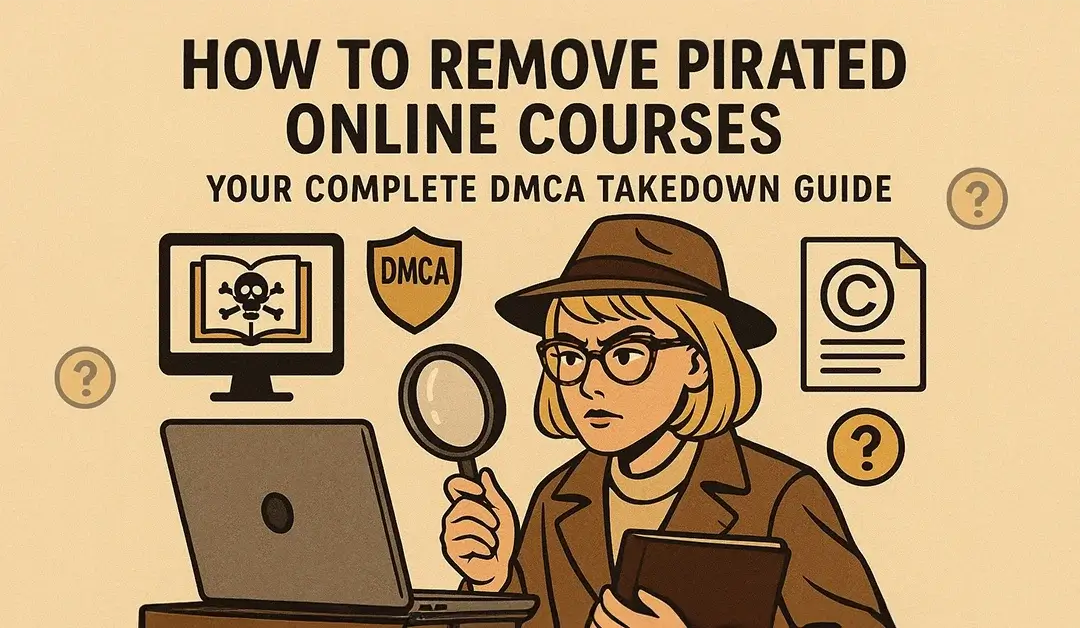Stop Course Pirates in Their Tracks: You Have More Power Than You Think
Here's the brutal truth: course piracy is rampant, but you're not powerless against it. While content creators often feel helpless watching their hard work get stolen, the reality is that you have legitimate legal tools at your disposal, and most platforms will actually help you when you use them correctly.
Let's cut through the noise and get your content protected. This isn't about playing defense; it's about taking control.
The Smart Way to Hunt Down Your Stolen Course Content
Step 1: Become a Digital Detective (It's Easier Than You Think)
Don't just Google your course name and hope for the best. Use these tactical search strategies:
Precision Search Queries:
- “your full name” “course name” download
- “course name” torrent OR free OR leaked
site:reddit.com "course name“download- site:facebook.com “course name” free
Pro tip: Create a spreadsheet to track every single URL you find. This isn't busywork—it's your ammunition for takedown notices.
Advanced Detection Strategy: Set up Google Alerts for your course name + terms like “free download,” “torrent,” or “leaked.” This gives you real-time notifications when new piracy pops up.
Step 2: Build Your Evidence Arsenal
Before you fire off takedown notices, gather proof that would hold up in court:
- Original course files with timestamps
- Screenshots of your official sales pages
- Purchase confirmations or student testimonials
- Creation dates and metadata from your source files
This evidence package proves ownership beyond any doubt.
The DMCA Takedown Process That Actually Works
Step 3: Master the DMCA Notice (Your Legal Superpower)
The Digital Millennium Copyright Act isn't just legal jargon, it's your best friend. Most legitimate platforms are legally required to respond to properly formatted DMCA notices.
Target These Platforms First (They Actually Respond):
- YouTube and Vimeo
- Facebook and Instagram
- Google Drive and Dropbox
- Major web hosting providers
- Educational platforms
Skip the Time-Wasters: Torrent sites and offshore platforms often ignore takedowns. Focus your energy where it counts.
Step 4: Craft Takedown Notices That Get Results
Here's a sample DMCA Letter template:
Subject: DMCA Takedown Notice – Copyright Infringement
Subject: DMCA Takedown Notice
To Whom It May Concern,
I, [Your Full Name], am the owner of copyrighted content hosted at [Your Website URL].
The following material infringes upon my copyrights:
[URL(s) of pirated content]
Original content: [URL of your legitimate content]
I request that you immediately remove the infringing material from your website.
I affirm under penalty of perjury that the above information is accurate, and I am authorized to act on behalf of the copyright owner.
Signature: [Your Name]
Date: [Today's Date]
Contact: [Your contact info]
Step 5: Hit Google Where It Hurts (SEO Protection)
If pirate sites are ranking in Google search results for your course name, you need to cut off their visibility at the source.
File a DMCA Notice Directly with Google: Use Google's DMCA Removal Form to remove infringing content from search results. This is crucial because even if the pirate site stays up, removing it from Google search results dramatically limits its reach.
Why This Matters: Most people find pirated content through Google searches. Remove the search visibility, and you've effectively neutered the pirate site's traffic.
Follow-Up Strategy That Ensures Compliance
Step 6: Monitor Like a Pro
Set up automated monitoring systems:
Free Options:
- Google Alerts for your course name
- Manual weekly searches using your proven queries
Premium Solutions:
- Copytrack for comprehensive monitoring
- Muso for entertainment content protection
- Digimarc for watermarked content tracking
Step 7: When to Bring in the Heavy Artillery
Consider professional DMCA services when:
- You're dealing with persistent repeat offenders
- The volume of piracy exceeds what you can handle manually
- You need ongoing monitoring and protection
Recommended Services:
- DMCA Pro – Known for handling bulk infringements efficiently
- Takedown Czar – Excellent for personalized assistance, especially with recurring piracy problems
- DMCAForce – Can handle takedowns and ongoing monitoring on your behalf
These professional services typically:
- Verify infringement claims
- File notices on your behalf
- Follow up to ensure compliance
- Provide ongoing monitoring
Prevention: Your Best Defense Strategy
Watermark Everything: Embed subtle identifiers in your videos that trace back to specific purchasers. This isn't just about detection—it's about deterrence.
Smart Release Strategy: Don't dump entire courses at once. Gradual releases make piracy less appealing and easier to contain.
Community Building: Engaged students are less likely to share content. Focus on creating exclusive communities around your courses.
Real Talk: What Actually Works vs. What Doesn't
What Works:
- DMCA notices to legitimate platforms (90%+ success rate)
- Professional monitoring services
- Watermarking and gradual content release
- Building loyal communities
What Doesn't Work:
- Trying to shut down every single pirate site
- Focusing on offshore torrent sites
- Legal threats without DMCA backing
- Ignoring the problem hoping it goes away
Action Plan: Your Next 30 Days
Week 1: Conduct comprehensive searches and document all piracy instances
Week 2: File DMCA notices for all mainstream platforms
Week 3: Set up monitoring systems and follow up on pending takedowns
Week 4: Evaluate results and consider professional services for persistent cases
Frequently Asked Questions
Most legitimate platforms respond within 24-72 hours. YouTube and Facebook often act within hours. If you don't hear back within a week, follow up aggressively.
Absolutely. Facebook, Instagram, Twitter, and LinkedIn all have DMCA processes. Social media piracy is often the easiest to remove because these platforms prioritize compliance.
Target their hosting provider instead. Use tools like WhoIs.net to identify the web host, then send your DMCA notice directly to them. Hosting providers almost always comply.
Absolutely. Filing a DMCA notice with Google removes infringing content from search results, which cuts off most traffic to pirate sites. Use Google's DMCA Removal Form—it's often more effective than trying to shut down the actual pirate site.
Focus on DMCA takedowns first. Legal action is expensive and time-consuming. Most pirates will disappear when their hosting gets pulled.
Watermark your content, build engaged communities, use gradual release strategies, and maintain ongoing monitoring. Prevention works better than reaction.
Minimal risk if your claims are legitimate. False DMCA claims can result in penalties, but if you own the content, you're protected. Always be truthful in your notices.
For legitimate platforms: 85-95% success rate. For offshore piracy sites: 10-20% success rate. Focus your energy where it counts.
Professional services can automate monitoring and filing, but initial manual research is usually necessary. Automation works best for ongoing protection rather than initial cleanup.
Basic monitoring starts around $50-100/month. Comprehensive takedown services range from $200-500/month depending on volume. Often worth it for high-value courses.
Original source files, timestamps, your official sales page, and clear proof of ownership. Screenshots of the pirate site help but aren't always necessary.

You didn't start your business to become a WordPress technician, yet here you are treating your most critical business asset like a hobby project. While you're spending hours on updates and crossing your fingers that nothing breaks, your competitors are focused on what actually makes money.
👋 I'm Jeane Sumner, and Website HQ doesn't just host your site – we armor it, optimize it, and monitor it so you can get back to running your business instead of fixing it. Book your Site Care strategy call and never worry about your website again.

